Amir Hussein
CS-FLEURS: A Massively Multilingual and Code-Switched Speech Dataset
Sep 17, 2025Abstract:We present CS-FLEURS, a new dataset for developing and evaluating code-switched speech recognition and translation systems beyond high-resourced languages. CS-FLEURS consists of 4 test sets which cover in total 113 unique code-switched language pairs across 52 languages: 1) a 14 X-English language pair set with real voices reading synthetically generated code-switched sentences, 2) a 16 X-English language pair set with generative text-to-speech 3) a 60 {Arabic, Mandarin, Hindi, Spanish}-X language pair set with the generative text-to-speech, and 4) a 45 X-English lower-resourced language pair test set with concatenative text-to-speech. Besides the four test sets, CS-FLEURS also provides a training set with 128 hours of generative text-to-speech data across 16 X-English language pairs. Our hope is that CS-FLEURS helps to broaden the scope of future code-switched speech research. Dataset link: https://huggingface.co/datasets/byan/cs-fleurs.
Factorized RVQ-GAN For Disentangled Speech Tokenization
Jun 18, 2025Abstract:We propose Hierarchical Audio Codec (HAC), a unified neural speech codec that factorizes its bottleneck into three linguistic levels-acoustic, phonetic, and lexical-within a single model. HAC leverages two knowledge distillation objectives: one from a pre-trained speech encoder (HuBERT) for phoneme-level structure, and another from a text-based encoder (LaBSE) for lexical cues. Experiments on English and multilingual data show that HAC's factorized bottleneck yields disentangled token sets: one aligns with phonemes, while another captures word-level semantics. Quantitative evaluations confirm that HAC tokens preserve naturalness and provide interpretable linguistic information, outperforming single-level baselines in both disentanglement and reconstruction quality. These findings underscore HAC's potential as a unified discrete speech representation, bridging acoustic detail and lexical meaning for downstream speech generation and understanding tasks.
Enhancing End-to-End Conversational Speech Translation Through Target Language Context Utilization
Sep 27, 2023



Abstract:Incorporating longer context has been shown to benefit machine translation, but the inclusion of context in end-to-end speech translation (E2E-ST) remains under-studied. To bridge this gap, we introduce target language context in E2E-ST, enhancing coherence and overcoming memory constraints of extended audio segments. Additionally, we propose context dropout to ensure robustness to the absence of context, and further improve performance by adding speaker information. Our proposed contextual E2E-ST outperforms the isolated utterance-based E2E-ST approach. Lastly, we demonstrate that in conversational speech, contextual information primarily contributes to capturing context style, as well as resolving anaphora and named entities.
Speech collage: code-switched audio generation by collaging monolingual corpora
Sep 27, 2023



Abstract:Designing effective automatic speech recognition (ASR) systems for Code-Switching (CS) often depends on the availability of the transcribed CS resources. To address data scarcity, this paper introduces Speech Collage, a method that synthesizes CS data from monolingual corpora by splicing audio segments. We further improve the smoothness quality of audio generation using an overlap-add approach. We investigate the impact of generated data on speech recognition in two scenarios: using in-domain CS text and a zero-shot approach with synthesized CS text. Empirical results highlight up to 34.4% and 16.2% relative reductions in Mixed-Error Rate and Word-Error Rate for in-domain and zero-shot scenarios, respectively. Lastly, we demonstrate that CS augmentation bolsters the model's code-switching inclination and reduces its monolingual bias.
Benchmarking Evaluation Metrics for Code-Switching Automatic Speech Recognition
Nov 22, 2022Abstract:Code-switching poses a number of challenges and opportunities for multilingual automatic speech recognition. In this paper, we focus on the question of robust and fair evaluation metrics. To that end, we develop a reference benchmark data set of code-switching speech recognition hypotheses with human judgments. We define clear guidelines for minimal editing of automatic hypotheses. We validate the guidelines using 4-way inter-annotator agreement. We evaluate a large number of metrics in terms of correlation with human judgments. The metrics we consider vary in terms of representation (orthographic, phonological, semantic), directness (intrinsic vs extrinsic), granularity (e.g. word, character), and similarity computation method. The highest correlation to human judgment is achieved using transliteration followed by text normalization. We release the first corpus for human acceptance of code-switching speech recognition results in dialectal Arabic/English conversation speech.
Code-Switching Text Augmentation for Multilingual Speech Processing
Jan 07, 2022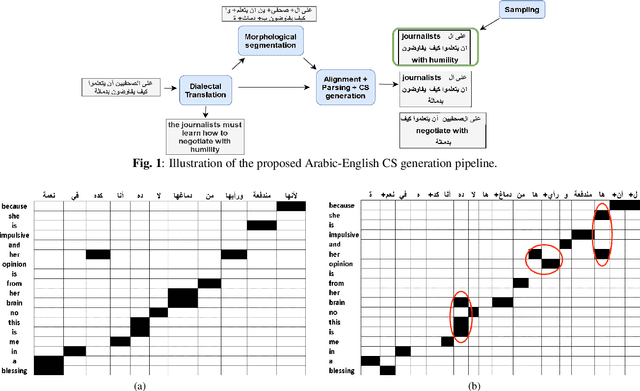
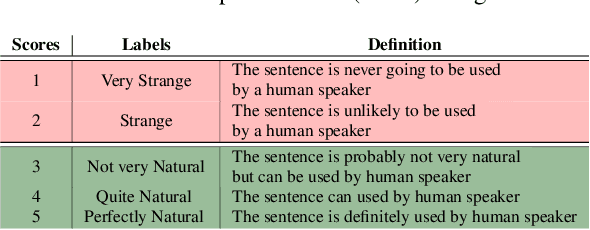

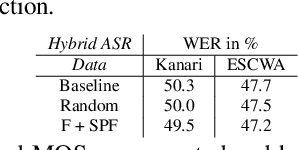
Abstract:The pervasiveness of intra-utterance Code-switching (CS) in spoken content has enforced ASR systems to handle mixed input. Yet, designing a CS-ASR has many challenges, mainly due to the data scarcity, grammatical structure complexity, and mismatch along with unbalanced language usage distribution. Recent ASR studies showed the predominance of E2E-ASR using multilingual data to handle CS phenomena with little CS data. However, the dependency on the CS data still remains. In this work, we propose a methodology to augment the monolingual data for artificially generating spoken CS text to improve different speech modules. We based our approach on Equivalence Constraint theory while exploiting aligned translation pairs, to generate grammatically valid CS content. Our empirical results show a relative gain of 29-34 % in perplexity and around 2% in WER for two ecological and noisy CS test sets. Finally, the human evaluation suggests that 83.8% of the generated data is acceptable to humans.
Arabic Code-Switching Speech Recognition using Monolingual Data
Jul 04, 2021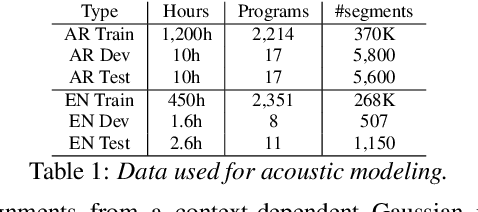

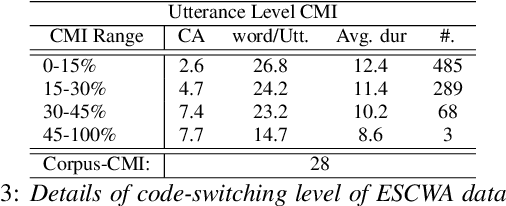
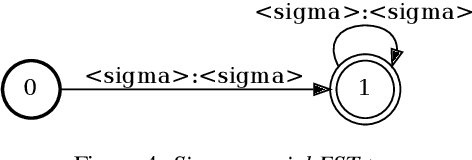
Abstract:Code-switching in automatic speech recognition (ASR) is an important challenge due to globalization. Recent research in multilingual ASR shows potential improvement over monolingual systems. We study key issues related to multilingual modeling for ASR through a series of large-scale ASR experiments. Our innovative framework deploys a multi-graph approach in the weighted finite state transducers (WFST) framework. We compare our WFST decoding strategies with a transformer sequence to sequence system trained on the same data. Given a code-switching scenario between Arabic and English languages, our results show that the WFST decoding approaches were more suitable for the intersentential code-switching datasets. In addition, the transformer system performed better for intrasentential code-switching task. With this study, we release an artificially generated development and test sets, along with ecological code-switching test set, to benchmark the ASR performance.
QASR: QCRI Aljazeera Speech Resource -- A Large Scale Annotated Arabic Speech Corpus
Jun 24, 2021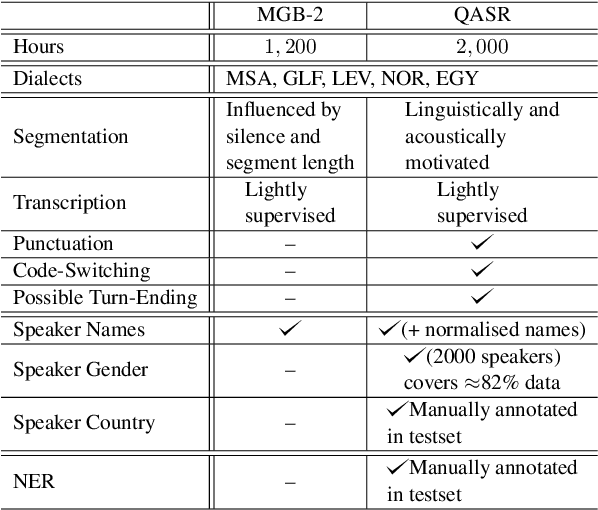
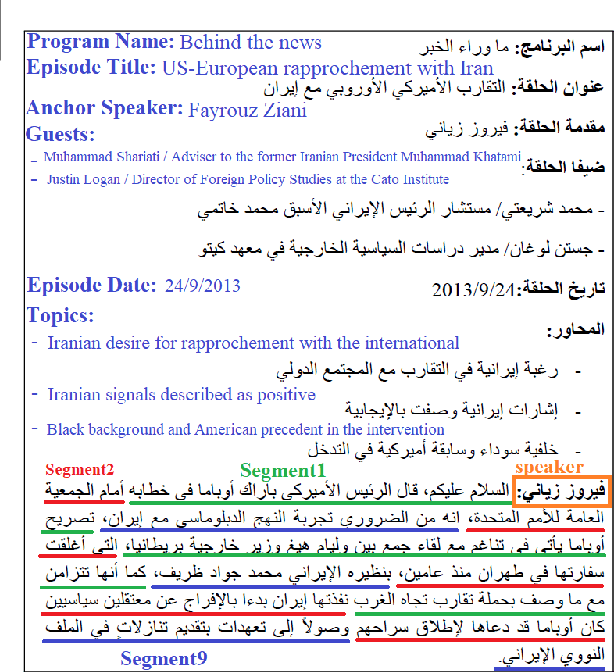
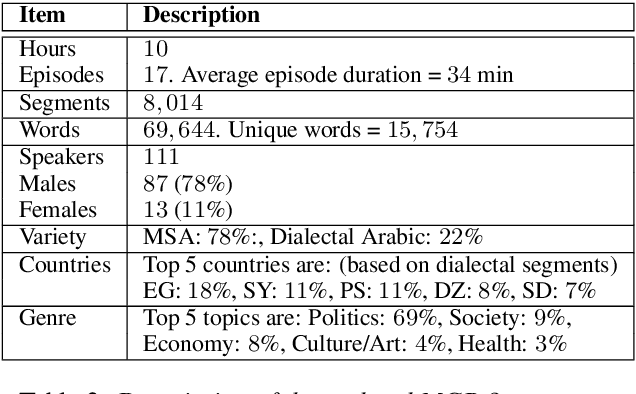
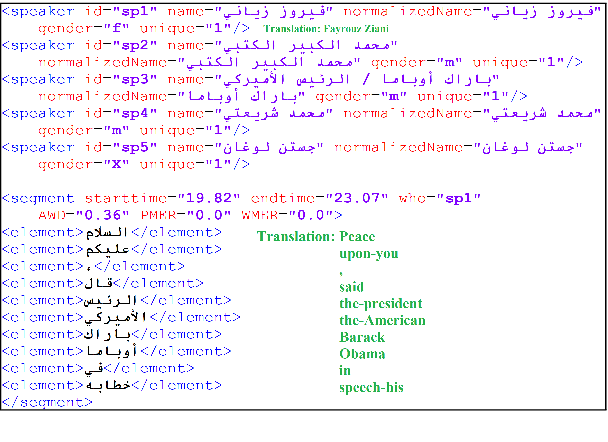
Abstract:We introduce the largest transcribed Arabic speech corpus, QASR, collected from the broadcast domain. This multi-dialect speech dataset contains 2,000 hours of speech sampled at 16kHz crawled from Aljazeera news channel. The dataset is released with lightly supervised transcriptions, aligned with the audio segments. Unlike previous datasets, QASR contains linguistically motivated segmentation, punctuation, speaker information among others. QASR is suitable for training and evaluating speech recognition systems, acoustics- and/or linguistics- based Arabic dialect identification, punctuation restoration, speaker identification, speaker linking, and potentially other NLP modules for spoken data. In addition to QASR transcription, we release a dataset of 130M words to aid in designing and training a better language model. We show that end-to-end automatic speech recognition trained on QASR reports a competitive word error rate compared to the previous MGB-2 corpus. We report baseline results for downstream natural language processing tasks such as named entity recognition using speech transcript. We also report the first baseline for Arabic punctuation restoration. We make the corpus available for the research community.
KARI: KAnari/QCRI's End-to-End systems for the INTERSPEECH 2021 Indian Languages Code-Switching Challenge
Jun 10, 2021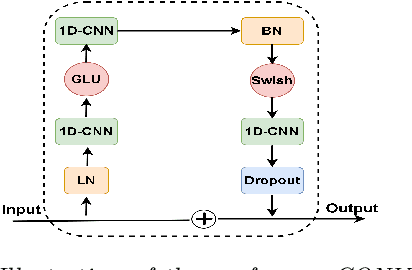
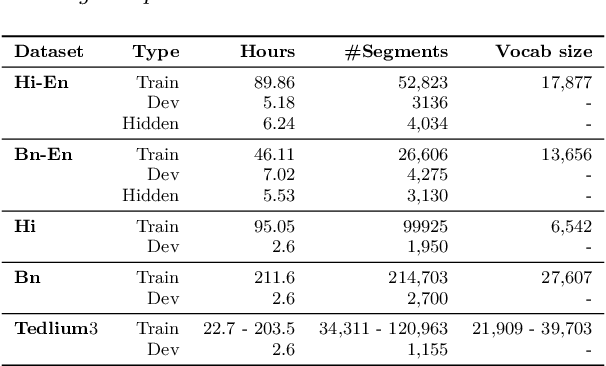
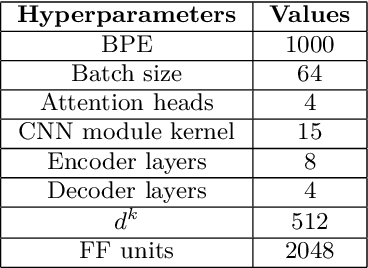

Abstract:In this paper, we present the Kanari/QCRI (KARI) system and the modeling strategies used to participate in the Interspeech 2021 Code-switching (CS) challenge for low-resource Indian languages. The subtask involved developing a speech recognition system for two CS datasets: Hindi-English and Bengali-English, collected in a real-life scenario. To tackle the CS challenges, we use transfer learning for incorporating the publicly available monolingual Hindi, Bengali, and English speech data. In this work, we study the effectiveness of two steps transfer learning protocol for low-resourced CS data: monolingual pretraining, followed by fine-tuning. For acoustic modeling, we develop an end-to-end convolution-augmented transformer (Conformer). We show that selecting the percentage of each monolingual data affects model biases towards using one language character set over the other in a CS scenario. The models pretrained on well-aligned and accurate monolingual data showed robustness against misalignment between the segments and the transcription. Finally, we develop word-level n-gram language models (LM) to rescore ASR recognition.
Towards One Model to Rule All: Multilingual Strategy for Dialectal Code-Switching Arabic ASR
May 31, 2021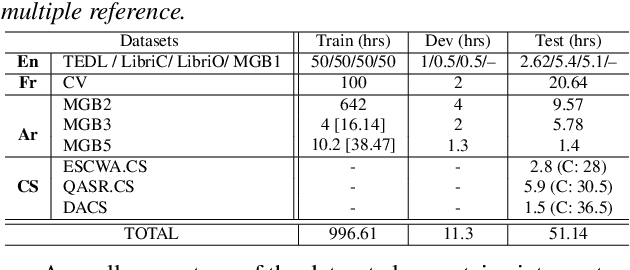
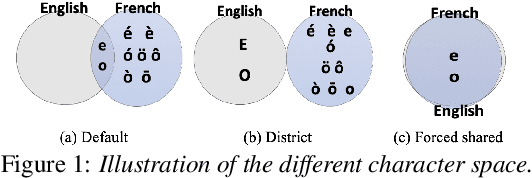
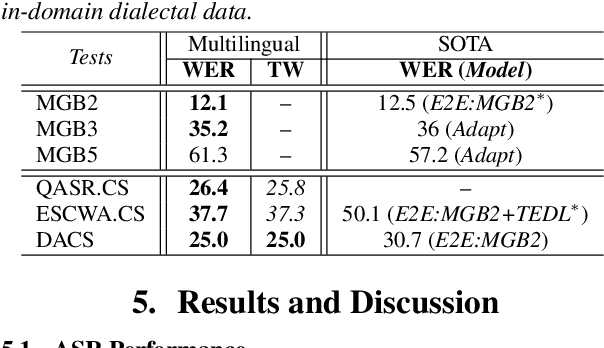
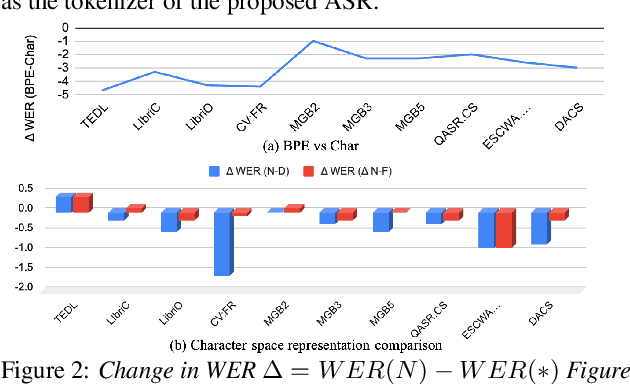
Abstract:With the advent of globalization, there is an increasing demand for multilingual automatic speech recognition (ASR), handling language and dialectal variation of spoken content. Recent studies show its efficacy over monolingual systems. In this study, we design a large multilingual end-to-end ASR using self-attention based conformer architecture. We trained the system using Arabic (Ar), English (En) and French (Fr) languages. We evaluate the system performance handling: (i) monolingual (Ar, En and Fr); (ii) multi-dialectal (Modern Standard Arabic, along with dialectal variation such as Egyptian and Moroccan); (iii) code-switching -- cross-lingual (Ar-En/Fr) and dialectal (MSA-Egyptian dialect) test cases, and compare with current state-of-the-art systems. Furthermore, we investigate the influence of different embedding/character representations including character vs word-piece; shared vs distinct input symbol per language. Our findings demonstrate the strength of such a model by outperforming state-of-the-art monolingual dialectal Arabic and code-switching Arabic ASR.
 Add to Chrome
Add to Chrome Add to Firefox
Add to Firefox Add to Edge
Add to Edge